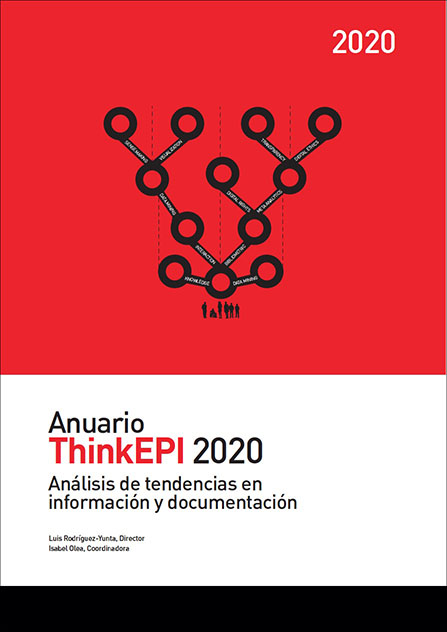Brief history of top-level domains and challenges for information professionals
DOI:
https://doi.org/10.3145/thinkepi.2020.e14f06Palabras clave:
Top-level domains, TLD, Web domains, Internet, Webometrics, ICANN, Information professional, Search engine optimization, SEOResumen
Top-level domains, in addition to fulfilling the technical function of enabling access to network resources, allow information professionals in generalóand content managers in particularóto work with domain names for branding and search engine optimization (SEO) purposes. Likewise, they facilitate the performance of metric analyses thanks to their hierarchical structure. The massive creation of new TLDs that was started in the early 21st century by the Internet Corporation for Assigned Names and Numbers (ICANN) opened the possibility of being able to select (or even register) a wide variety of web domains. However, the sources of information about TLDs as well as their management and usefulness for both the commercial sector (SEO, web content management, and digital analytics) and scholarly community (webometrics) are not well known among information professionals. The objective of this text is to explain the meaning and function of TLDs, to highlight their different categories, and to show their evolution over time, in order to provide useful information for professionals dedicated to the generation, dissemination, storage/retrieval, and analysis of online content.
Citas
Brí¼gger, Niels (2018). The archived web: Doing history in the digital age. Massachusetts: MIT Press. ISBN: 978 0 262 03902 4
Christou, George; Simpson, Seamus (2009). "New governance, the internet, and country code top"level domains in Europe". Governance, v. 22, n. 4, pp. 599-624. https://doi.org/10.1111/j.1468-0491.2009.01455.x
Elz, Robert; Bush, Randy (1997). Clarifications to the DNS specification. Internet engineering task force (IETF). Network Working Group. RFC 2181. https://tools.ietf.org/html/rfc2181
Farley, Christine H. (2007). "Convergence and incongruence: trademark law and ICANN´s introduction of new generic top-level domains". 25 John Marshall journal of computer & information law, v. 625. https://ssrn.com/abstract=1400304
Halvorson, Tristan; Szurdi, Janos; Maier, Gregor; Felegyhazi, Mark; Kreibich, Christian; Weaver, Nicholas; Levchenko, Kirill; Paxson, Vern (2012). "The BIZ top-level domain: ten years later". In: International Conference on Passive and Active Network Measurement, pp. 221-230. ISBN: 978 3 642 28537 0 https://doi.org/10.1007/978-3-642-28537-0_22
Lindsay, David (2007). International domain name law: ICANN and the UDRP. Portland, Oregon: Hart Publishing. ISBN: 978 1 84113 584 7.
Mac-Síthigh, Daithí (2010). "More than words: the introduction of internationalised domain names and the reform of generic top-level domains at ICANN". International journal of law and information technology, v. 18, n. 3, pp. 274-300. https://doi.org/10.1093/ijlit/eaq007
Mahler, Tobias (2019). Generic top-level domains: A study of transnational private regulation. Cheltenham: Edward Elgar Publishing. ISBN: 978 1 78643 514 9
Mockapetris, Paul (1983a). Domain names - concepts and facilities. Task Force (IETF). Network Working Group. RFC 882. https://tools.ietf.org/html/rfc882
Mockapetris, Paul (1983b). Domain names - implementation and specification. Task Force (IETF). Network Working Group. RFC 883. https://tools.ietf.org/html/rfc883
Mockapetris, Paul (1987a). Domain names - concepts and facilities. Task Force (IETF). Network Working Group. RFC 1034. https://tools.ietf.org/pdf/rfc1034
Mockapetris, Paul (1987b). Domain names - implementation and specification. Task Force (IETF). Network Working Group. RFC 1035. https://tools.ietf.org/pdf/rfc1035
Mueller, Milton L. (1998). "The battle over Internet domain names: Global or national TLDs?". Telecommunications policy, v. 22, n. 2, pp. 89-107. https://doi.org/10.1016/s0308-5961(97)00062-1
Orduña-Malea, Enrique; Aguillo, Isidro F. (2015). Cibermetría. Midiendo el espacio red. Barcelona: UOC Publishing. ISBN: 978 84 9064 654 0.
Postel, Jonathan B. (1984a). Domain name system implementation schedule - Revised. Network Working Group. Request for Comments: 921. https://tools.ietf.org/html/rfc921
Postel, Jonathan B. (1984b). Domain name system implementation schedule. Network Working Group. Request for Comments: 897. https://tools.ietf.org/html/rfc897
Postel, Jonathan B. (1994). Domain name system structure and delegation. Network Working Group. Request for Comments: 1591. https://tools.ietf.org/pdf/rfc1591
Postel, Jonathan B.; Reynolds, Joyce K. (1984). Domain requirements. Network Working Group. Request for Comments: 920. https://tools.ietf.org/html/rfc920
Shimanoff, Eric J. (2013). "The dot times they are a-changin´: how new generic top level domains (gTLDS) will change consumer perception about the internet". Cardozo arts & entertainment, v. 32, pp. 891-926. https://www.cll.com/media/publication/27_Shimanoff%20Article.pdf
Smith III, Joseph P. (2013). "The tangled web: A case against new generic top-level domains". Richmond journal of law & technology, v. 20, n. 3, pp. 1-42. https://jolt.richmond.edu/2014/06/23/the-tangled-web-a-case-against-new-generic-top-level-domains


